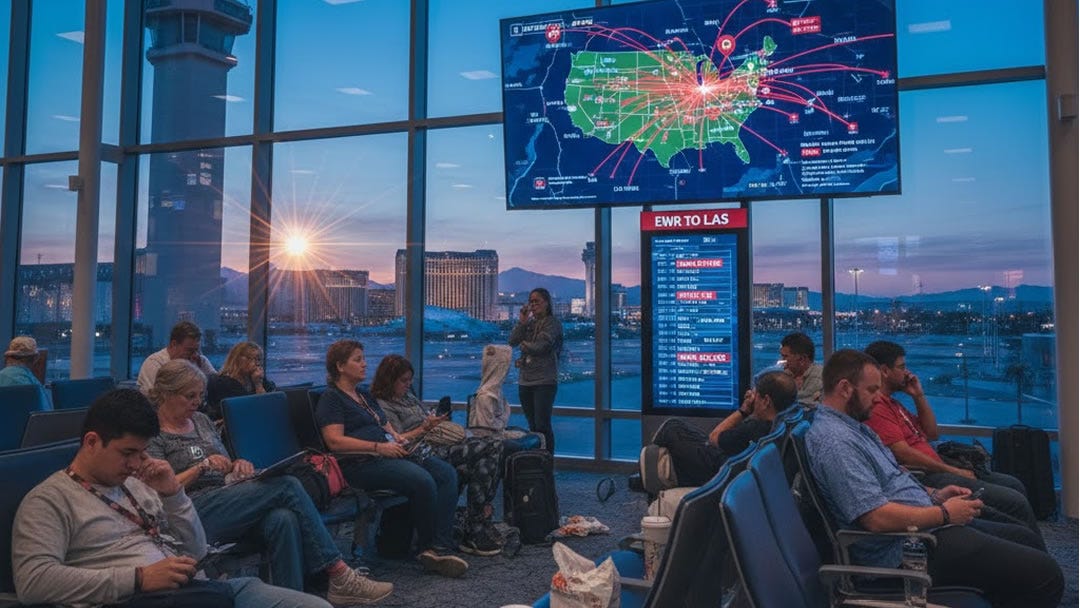Las Vegas: Always at the losing end of the airline ripple effect
Being Prepared for what's coming
Being a busy West Coast airline hub, Las Vegas’s International Airport (LAS) is always at the losing end of the ripple effect of anything happening on the East Coast.
And now that the government shutdown has hit the friendly skies and the FAA is forced to mandate capacity reductions (like the rumored 10% cut at 40 major hubs), airlines are scrambling. Every air traffic controller's absence, every flight slowdown in New York or Atlanta, translates into an amplified delay by the time a plane arrives here in the desert.
This air traffic crisis forces airlines to get incredibly creative—not just in cutting flights, but in managing their most vital, expensive assets: their aircraft and their crews.
Part 1: How Airlines Master the Juggling Act
The goal for every airline is to maintain a semblance of a schedule while complying with FAA capacity limits. This requires constant strategic maneuvering behind the scenes:
1. Strategic Fleet Repositioning and “Up-Gauging”
When the FAA limits the number of takeoffs an airport can handle per hour, airlines can’t afford to let their largest planes sit idle.
Proactive Capacity Cuts: Airlines often file for an FAA “slot waiver,” which allows them to reduce their flight frequency on certain routes without forfeiting their highly valuable landing and takeoff slots for future seasons.
The Big Swap: Instead of canceling a popular route, they might use a larger aircraft (e.g., swapping a 737 for a wide-body 787). This reduces the total number of flights needing controller clearance while maximizing the number of passengers they can move.
You may find yourself on the same flight, but with a different plane and a seating arrangement that differs from what you booked. This can cause confusion and frustration.“Ferry Flights” (Flying Empty): If a vital, high-value plane is stuck on the East Coast due to delays, the airline might choose to fly it to its next destination empty. While costly, this “ferry flight” protects the rest of the network schedule, especially if that plane is needed for an international route or a major bank of LAS departures the following morning.
2. Crew Management Under Pressure
The government shutdown has caused controllers to work without pay, leading to higher sick-call rates—a crisis that also affects crew availability due to maximum duty limits.
Reserve Deployment: Airlines strategically place reserve crews in key hubs, including LAS, ready to step in instantly. When a crew is delayed and “times out” (reaches the legal limit of their shift), having a reserve team ready to take over a late-arriving flight is the only thing that prevents an outright cancellation.
Re-Routing & Flow Management: Airline operational centers work directly with the FAA’s Air Traffic Control System Command Center (ATCSCC). They file new flight plans that avoid short-staffed control centers or congested airspace, even if it means a longer, more fuel-intensive route. For a flight heading to LAS, this might mean a significant detour to avoid a regional control center experiencing a 50% staffing cut.
In other words, get ready to bite your tongue as people get grouchy, demanding, and irritable at the overworked, understaffed gates and ticket counter. Please remember: Some things are best left unsaid!
Part 2: Travelers: Your Survival Guide to Vegas Delays
Since you can’t control airline logistics, your best bet is preparation. Here is how East Coast and international travelers can take control of their journey to the Entertainment Capital of the World:
Proactive Strategy
If you can, book the First Flight Out
Why? Morning flights are less likely to be impacted by cumulative delays from previous flights and staffing issues throughout the day. If a delay occurs, you have all day to recover.
Track Your Plane
Why? Use apps like FlightAware to follow the exact aircraft (and its crew) that is scheduled to operate your flight. If it’s delayed getting to your departure city, you can expect your flight to be delayed as well.Pack a “Delay Kit”
Why?": Carry an emergency carry-on kit: a high-capacity portable power bank, downloaded movies/podcasts (don’t rely on Wi-Fi), noise-canceling headphones, and essential medications.
Ideas for the “Delay Kit”
Maintain Connection - High-Capacity Power Bank & Long Cables
Tune Out Chaos -Noise-Canceling Headphones & Eye Mask
Ensure Comfort - Neck Pillow & Cozy Scarf/Jacket
Fight Boredom - Downloaded Movies/E-reader
Stay Refreshed - Reusable Water Bottle & Toothbrush Kit
Your Medication!
Allow a Massive Buffer
Why? If you have a connecting flight, especially coming from an international destination, allow at least 3-4 hours between flights. This buffer is critical for clearing customs and surviving a flight that arrives late.Know Your Re-Route Options
Why? If your flight is canceled, immediately check the airline’s app for rebooking options while you call their customer service number. Do not just wait in the customer service line (where everyone else is heading to), you need to work multiple channels to secure the next available seat.
Remember: You’ve prepared well. Your bags are packed, your apps are ready, and now all that’s left is the mental victory of turning the delay into a peaceful moment just for you. Relax, breathe.
No Matter What, Vegas will be here waiting for you!
Your Thoughts?
Mark Anthony
The Vegas Tourist
P.S. Don’t forget, our Vegas Survival Kit, featuring chargers, cooling gear, and more, is a must-have before your trip. Click here to pack smarter
P.S.S. Have you booked a tour yet? The future you will thank you for saving the hassle! Click to Book



